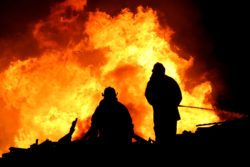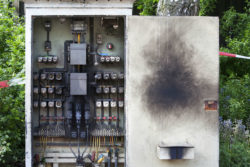Top Class Actions’s website and social media posts use affiliate links. If you make a purchase using such links, we may receive a commission, but it will not result in any additional charges to you. Please review our Affiliate Link Disclosure for more information.

Pacific Gas & Electric currently faces more than $30 billion in liabilities for its alleged role in causing the fires. The California Department of Forestry and Fire Protection (CAL FIRE) has officially found PG&E responsible for 2018’s deadly Camp Fire in Butte County, which killed 85 people, destroyed the town of Paradise and scorched 150,000 acres.
While the survivors of the California wildfires of the past few years struggle to rebuild their lives, previously-convicted corporate felon PG&E is attempting to escape its liabilities by seeking bankruptcy protection. They are being enabled by lawmakers who are attempting to provide “relief” for yet another corporate “person” that has been deemed “too big to fail.” To add insult to injury, the state legislature passed a bill in September that would essentially force victims of the fires as well as other ratepayers to foot the bill for fighting the fires as well as cleanup and future prevention.
Latest figures put damages from Northern and Southern California wildfires at $12 billion.
The California Wildfires of 2018
Last year saw the deadliest and most destructive wildfires in California’s 170-year history. Between mid-July and the end of November, 2018, well over 8,500 fires destroyed nearly 2 million acres. The largest of these was the Mendocino Complex Fire, which was actually two wildfires that occurred in the Clear Lake region approximately 140 miles northwest of Sacramento.
First reported on July 27, the Mendocino Complex Fire was finally 98 percent contained by September 4. “Hotspots” continued to smolder until early November, however.
Altogether, there were a total of 58 wildfires across the Golden State burning between February 18 and November 22, the deadliest of which was the Camp Fire.
A Disaster Waiting to Happen
In addition to being the most disastrous wildfire in California history, the Camp Fire was the deadliest fire in the U.S. in 100 years in terms of lives and property lost. It also holds the dubious record for being the costliest natural disaster on the planet in 2018.
In retrospect, the Camp Fire disaster should not have been unexpected, particularly in light of the impact of global climate change and resultant dry, hot conditions. The fire started near the town of Paradise along Camp Creek Road (which gave the fire its name), located in Butte County approximately 90 miles north of Sacramento.
The region had seen 13 sizable California wildfires over the previous two decades; in 2005, CAL FIRE published a fire management strategy for the area, warning that the town of Paradise was at risk for a major conflagration. According to the report, the town’s very location near the mouth of a narrow canyon coming out of the Sierra Nevada mountains and roads that had “significant constraints” and “capacity limitations” that offered little opportunity for escape made the entire community a potential death trap.
Short Sightedness Hampered Fire Prevention Measures
In 2011, the State of California began assessing a special tax on property owners for the purpose of financing fire prevention efforts. Eventually, this fire prevention levy enabled the building of escape routes and the clearing of underbrush and dead vegetation that might fuel California wildfires. Nonetheless, the tax was very unpopular with GOP lawmakers as well as anti-tax organizations and property owners; in 2017, after collecting $470 million, the tax was repealed.
By the beginning of November, abnormally dry conditions, low humidity and hot, dry winds gusting out of the canyons east of the town had turned the region into a veritable powder keg.
Investigations Revealed Poor Powerline Maintenance
Inspection of PG&E equipment and transmission lines falls under the auspices of the California Public Utilities Commission (CPUC). However, according to a PG&E investigation by a San Francisco NBC news affiliate, the CPUC had failed to audit PG&E in order to ascertain that the utility was carrying out routine inspections of the high voltage transmission lines in the area where the fire ignited.
Earlier inspections had revealed serious hazards that included tree contact with electrical equipment, a pole that did not meet current standards and transformers that had not been bolted down properly. A few years earlier, the CPUC had found that PG&E was not inspecting its equipment in many areas in the Sacramento Valley.
On Nov. 6, 2018, PG&E began issuing notifications to its customers that power might be cut off because of high winds and dry conditions. However, that shut down never took place. The day before the fire started, PG&E contacted a customer in the area, advising her of “problems with sparks” and informing her that utility workers would need to come on to her property in order to address the problem.
Around 6:15 on the morning of November 8, PG&E noted problems with a transmission line near the town of Pulga. Less than 20 minutes later, CAL FIRE received reports of a fire burning underneath power lines in the area. Photos and video footage later revealed that an insulator had come loose from a tower, causing power lines to fall to the ground.
The fire’s location was accessible by roads that were too narrow for fire engines, and high winds prevented aircraft from taking off. By 8:00 AM, the fire had spread to the town of Paradise. Fueled by 50 mile-per-hour winds, firefighters were unable to take action beyond attempts to get people out of harm’s way.
Aftermath
Beyond the deaths of at least 85 people (17 suffered injuries, and three more have never been found) and the destruction of over 18,600 buildings (more than half of which were family dwellings), the Camp Fire resulted in what one physician described as “the worst air pollution ever for the Bay Area and northern California.” In addition to smoke from burning vegetation, that pollution contained highly toxic contaminants that included asbestos, arsenic, dioxins and heavy metals.
A Butte County health official issued a strong warning against attempts to rebuild the towns that were destroyed because of the toxic chemicals that had been released by the fire.
According to a report from NPR, thousands of homes lost to the Camp Fire have yet to be rebuilt.
Economically, the consequences have been equally disastrous. Claims totaling $25 billion put Merced Property and Casualty Company, a 115-year-old insurance company, out of business. In nearby Chico, landlords, realtors and merchants lost no time in taking advantage of victims, raising the costs of housing so suddenly and sharply that the town’s city council had to pass an emergency ordinance to stop price gouging, limiting rent and food price increases to 10 percent over a six-month period. The economic fallout reflects poorly on the lawmakers who are attempting to pass wildfire relief legislation to support PG&E.
Investigations Confirm PG&E Role
PG&E officials admitted at the time that the Camp Fire was likely to have started because of a faulty transmission line. A subsequent CAL FIRE investigation has now confirmed PG&E’s admission; in addition to the original fire near Pulga, investigators identified a second ignition point several miles to the west, where vegetation had been in physical contact with company transmission lines. According to CAL FIRE, the two California wildfires eventually combined into one to create the inferno that virtually wiped out two communities.
The news came as no surprise to survivors. One of them told the San Francisco Chronicle, “I just always assumed they were responsible…we were ready for the power to be off, and they didn’t shut it off…it was really windy that day. They had a chance to prevent it, and they chose not to do that.”
Could PG&E Face the Corporate “Death Penalty”?
Results of the CAL FIRE investigation not only paves the way for lawsuits that are already underway, they have also opened the door to criminal prosecution for murder.
As noted earlier, PG&E is already a convicted felon. In January of 2017, a federal court found the company guilty on five counts of violating federal pipeline safety rules and one count of obstructing an investigation by the National Transportation Safety Board in connection with the 2010 San Bruno gas pipeline explosion, which killed eight people. Before that, PG&E was found guilty of safety violations that resulted in a gas explosion near Sacramento in December of 2008, which killed one person and inured five others.
PG&E has already paid hundreds of millions of dollars in fines, has been ordered to perform 10,000 hours of community service and is currently on probation for the San Bruno incident.
Now, PG&E faces an estimated $30 billion in liability over California wildfires; however, now that the corporate recidivist is now in bankruptcy, it is unclear how much of that will be recovered by its victims. Being as the Supreme Court has conferred personhood status on corporations, an increasing number of victims are demanding that corporate felons such as PG&E face human penalties as well – including capital punishment. In the case of a corporate criminal, this “death penalty” would involve revoking its charter and selling off its assets to smaller companies.
Unfortunately, politicians and courts are protecting a criminal enterprise that they have deemed “too big to fail” – and apparently, too big to be held fully accountable. In the meantime, survivors of California wildfires continue to struggle in the face of rising costs, dwindling insurance settlements, delays in restoration due to a shortage of contractors and materials, and a government that cares only for wealthy and powerful interests.
PG&E is not the only large power company that has been implicated in California wildfires; in February, 2019, SoCal Edison admitted that the Woolsey Fire of 2018 was started by a live electrical wire on a property near Ventura. That fire destroyed over 1600 buildings and killed three people. Los Angeles County has filed a lawsuit against SoCal Edison, seeking to recover over $100 million in fire-related costs.
Join a Free California Wildfire Property Damage Lawsuit Investigation
If you or a loved one suffered property damage in the Camp Fire, Woolsey Fire, Hill Fire or last year’s Thomas Fire, legal help is available to help you through the claim process with your insurance company.
This article is not legal advice. It is presented
for informational purposes only.
ATTORNEY ADVERTISING
Top Class Actions is a Proud Member of the American Bar Association
LEGAL INFORMATION IS NOT LEGAL ADVICE
Top Class Actions Legal Statement
©2008 – 2024 Top Class Actions® LLC
Various Trademarks held by their respective owners
This website is not intended for viewing or usage by European Union citizens.
Get Help – It’s Free
Join a Free California Wildfire Property Damage Lawsuit Investigation
If you qualify, an attorney will contact you to discuss the details of your potential case at no charge to you.
PLEASE NOTE: If you want to participate in this investigation, it is imperative that you reply to the law firm if they call or email you. Failing to do so may result in you not getting signed up as a client or getting you dropped as a client.
E-mail any problems with this form to:
Questions@TopClassActions.com.
Oops! We could not locate your form.













